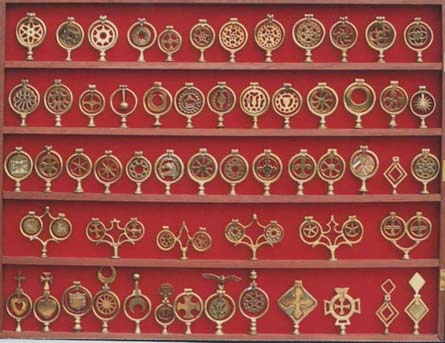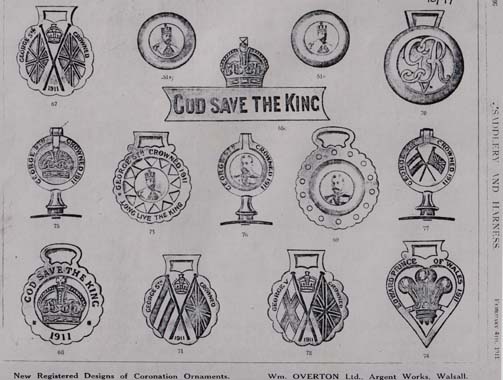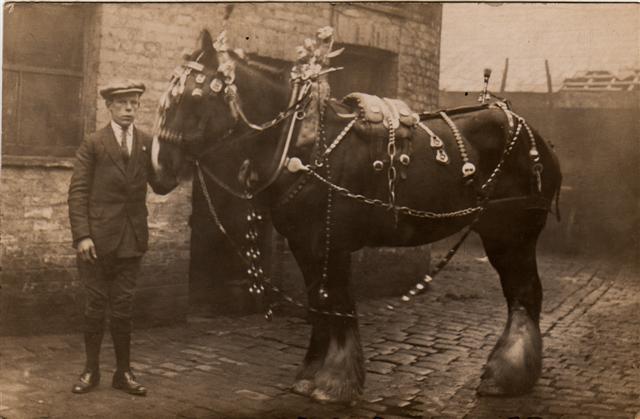Birmingham & Walsall, Pattern Books
Throughout the 19th C as the fashion for harness decorations steadily grew their manufacture became a sizeable industry and although many other smaller foundries across Britain may have had some horse brass output, from the mid to late 19th C onwards the manufacrture of the largest range of decorative brassware was centred on the areas of Birmingham and Walsall in the West Midlands. Birmingham had long been an industrial centre specialising in metal goods, mainly due to the fact that the raw materials needed for the production of metals, such as water, coal and wood were all readily available nearby.
Another reason for the industry developing in Birmingham was because long-established metal working skills were already in the area, including several manufacturers that specialised in carriage and harness ware. By 1880 there were dozens of businesses established in this area producing a range of harness brassware, which is clearly apparent in the surviving examples of manufacturers catalogues.
If a collector is lucky enough to find an original volume it will probably be the famous Equine Album of Hampson & Scott of Walsall, dating from c.1895-1905. This 260-page catalogue catered for all the needs of the saddler or horseman. The company not only produced its own wares but acted as a merchandising umbrella for many smaller companies whose products are also included in the Equine Album. Some of Hampson & Scott’s more colourful articles such as their May Day flowers, tapes and fringing were also included in an American catalogue: Mosemans Illustrated Guide for Purchasers of Horse Furniture and Goods.
Below, A page from Hampson & Scott’s Equine Album showing cast face pieces
Other saddlery catalogues included:
Thomas Newton’s ‘Saddlery of all Nations’, 1871.
Matthew Harvey of Walsall, 1880 and 1902.
R E Thacker of Walsall’s ‘The Four In Hand’, 1905.
William Overton of Walsall also manufactured brasses but was probably best known for their Royal Commemorative brasses which were advertised in special leaflets and other advertisements appearing at the time of the coronations of Edward VII and George V, as shown below, taken from the magazine Saddlery and Harness, though the original plate was then in colour. These brasses were finished to a very high standard, many of them introducing coloured enamel into their design.
Fly Head Terrets (Swingers)
‘Fly head terrets’ as they are described in the manufacturers’ catalogues are today better known as ‘swingers’ and in their simplest form are a plain hinged disc swinging within a circular fixed terret, the name by which the rein loops fitted to hames and saddles are known. One swinger would be screwed to the head strap of the bridle placed between the horse’s ears and in the case of the Scottish harness spiked into the high peak of the closed collar. Folklore tradition has it that the polished swinging disc produced a sun flash said to ward off evil spirits but a more practical explanation was to discourage flies from bothered horses, and this gave rise to them being described as fly terrets. When fitted with a small bell they played a part in warning of an approaching horse and cart in a narrow lane.
When introduced in the mid 19th C the swinger gained popularity and became more elaborate in design so that they now resembled a full size hanging brass and were soon being sold together as matching sets. Both pattern and bell terrets began to be made in multiple configurations of two or three separate rings with plumes added to the top of the frame. These complex creations were now attached to the saddle ridge and even the horse’s rump strap, particularly on decorated show harness, which became a feature especially in Cornwall.
Below, a good example of a decorated harness from Manchester about 1912. Note the bell terrets mounted on the head and the rump of this horse

By the late 19th C most manufacturers’ catalogues had a page or two dedicated to terrets such as those illustrated by Messrs Hampson & Scott or other specialist manufacturers in Birmingham or Walsall.
The page illustrated below however is one of those rare exceptions and is taken from the pattern book of Shattock & Hunter,which was a Bristol firm.

This splendid colour illustration from their catalogue shows a good selction of the many designs available to the working horseman in the 1890s. Note also the two smaller swingers at the bottom of the page that were made for pony or ‘vanner’ harness. Also shown are several examples of the terrets known as ‘tumblers’ with their double-centred designs, which did exactly what their name suggests, tumbling over and over in their frames, rather than just swinging back and forth.
Below, four royalty swingers. Note how the George V crown allowed a space within it to add a piece of worsted cloth or ribbon for colour






